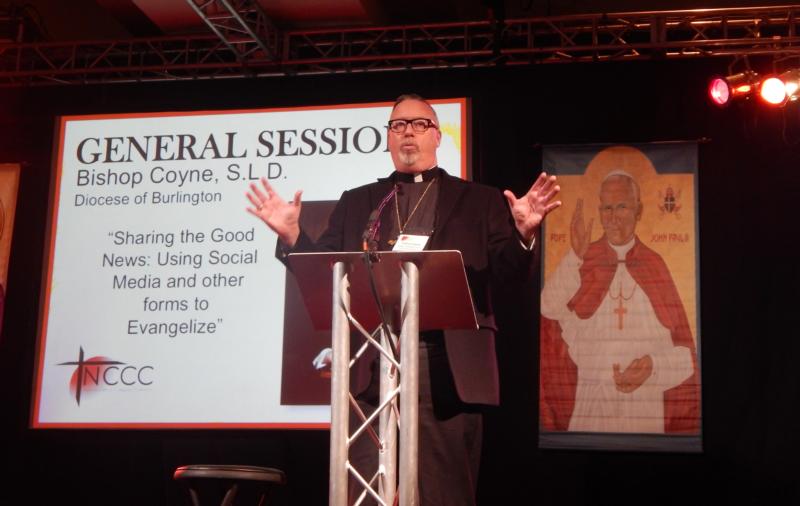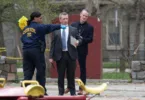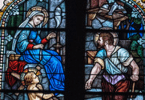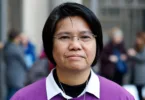
Bishop Christopher J. Coyne of Burlington, Vt., addresses young adults Nov. 21 during the National Catholic Collegiate Conference in Indianapolis. (CNS photo/Mike Krokos, The Criterion)
by Mike Krokos
INDIANAPOLIS (CNS) — Digital media offers the Catholic Church another opportunity to spread the good news of the Gospel, which is what faith calls Catholics to do, Vermont Bishop Christopher J. Coyne recently told a national gathering of young adults in Indianapolis.
“The church has done this from the beginning, using whatever means of communications that we could, from the letters of (St.) Paul to the printing press, to radio to television, and now to the Internet and digital media,” he told nearly 300 young adults. “The church has seen these things as tools to spread the good news.”
Bishop Coyne heads the Diocese of Burlington, Vermont, and is chairman of the U.S. Conference of Catholic Bishops’ Committee on Communications. He was a keynote speaker during the National Catholic Collegiate Conference, which is open to people ages 18-25 and held simultaneously with the National Catholic Youth Conference.
The collegiate conference was co-sponsored by the National Catholic Young Adult Ministry Association and the National Federation for Youth Ministry.
In his Nov. 21 talk, titled “Sharing the Good News: Using Social Media and Other Forms to Evangelize,” Bishop Coyne, a former auxiliary bishop of the Archdiocese of Indianapolis, called digital media a “neutral tool. It’s the content that makes things different.”
That content, he continued, is more than just the Internet, it’s websites and videos, blogs, podcasts, images and text.
“It is also social media, like Twitter, and Instagram, and GooglePlus and LinkedIn, and Periscope and Meerkat,” Bishop Coyne said. Meerkat is a new mobile app through which users can broadcast on their phones to anyone else using Meerkat.
Content also includes text messaging, livestreaming, FaceTime and Skype. “It is global and it is local. It is fast, instant, intense and gigantic. More than 1 billion people are on Facebook,” he noted. “More than 100 million people use Instagram every month, there are 304 million monthly active users on Twitter, and there are almost as many cellphone subscriptions — 6.8 billion — as there are people. There’s only 7 billion people.”
Why does the Catholic Church need to be present in digital media?
“Because we have to be if we want to go out and spread the good news,” he said. “It’s where Catholics and potential Catholics can be found.”
Bishop Coyne, who blogs and also can be followed on Twitter @bishopcoyne, offered an example of how digital media played a key communications role during Pope Francis’ recent visit to the U.S.
The USCCB, he said, set up social media platform rooms in all three cities the pope visited — Washington, New York and Philadelphia — that were manned by 20 to 25 volunteers and some professional staff.
“What they did all day long was they were in the room with their computers, and they were just basically paying attention to what was going on on Twitter, what was going on on the USSCB hashtags, what was going on in terms of Facebook,” he noted.
Over the six-day period, Bishop Coyne said, the USCCB team produced nearly 2,500 pieces of social media content, including 62 real-time videos in English and Spanish, which resulted in 18.5 million content impressions.
“That’s 3,000 impressions per minute. That’s people coming to check it out, looking at it,” he noted. “During the week, the English and Spanish Facebook page posts reached 8 million people, and engaged a half million of them.
“They had 1.65 million video views, [and] they had 5.1 billion tweets and retweets using their hashtags.”
Pope Francis’ visit, he added, “clearly shows that the use of digital media as a means to spread the good news is not just a possibility but is in fact a reality.”
Bishop Coyne asked the young people to “use the creativity you already possess and the tools you already have to be digital missionaries, fiber apostles, and cloud evangelists.”
He also encouraged them to sow seeds of goodness, “saying only the good things that men and women truly need to hear, things that will really lift them up. You never know how the seeds will grow, but that’s not your worry. You’re just the sower. You just spread the good news.”
St. Therese of Lisieux, who was known for her “little way,” would be a good patron saint for those involved in digital media, he added.
“Much of the time you will spend in digital media,” Bishop Coyne said, “is in the small moments: e-mails, tweets, posting pictures, links to videos and websites, answering questions. They’re small moments. But they’re small moments to love.”






